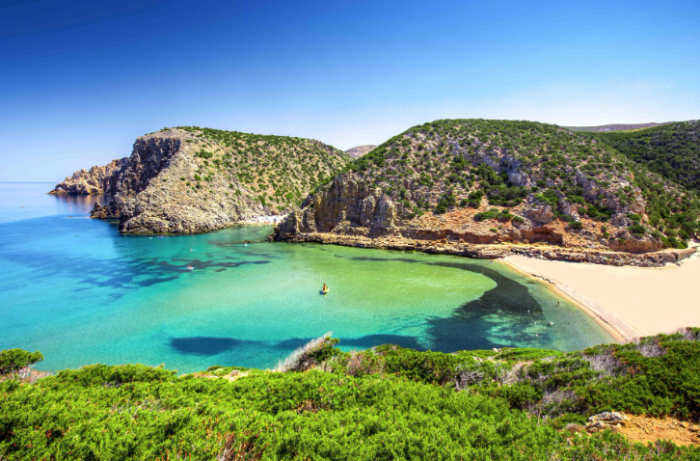Table of Contents
- 1. The Amalfi Coast: A Symphony of Cliffs and Crystal Waters
- 2. Sardinia: The Island of White Sands and Emerald Seas
- 3. Sicily: Where History Meets Coastal Beauty
- 4. Puglia: The Heel of Italy’s Boot
- 5. Liguria: The Italian Riviera
- 6. Tuscany: Beyond the Renaissance
- 7. Calabria: The Toe of Italy’s Boot
- Practical Tips for Visiting Italy’s Best Beaches
Looking for the best beaches in Italy? Discover stunning coastlines from the Amalfi Coast to Sardinia, Sicily, Puglia, Liguria, Tuscany, and Calabria. Explore crystal-clear waters, golden sands, and hidden gems across Italys top seaside destinations for an unforgettable Mediterranean escape.
1. The Amalfi Coast: A Symphony of Cliffs and Crystal Waters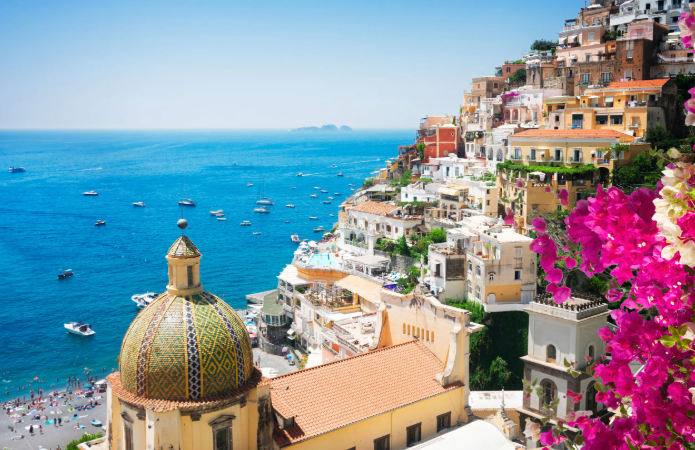
No discussion of Italy’s best beaches would be complete without mentioning the Amalfi Coast. This UNESCO World Heritage Site is renowned for its dramatic cliffs, pastel-colored villages, and turquoise waters. While the coastline is more famous for its scenic drives and luxury hotels, it also boasts several hidden gems along its rocky shores.
Best Beaches in the Amalfi Coast:
- Marina Grande, Positano: Often overshadowed by Positano’s vertical charm, Marina Grande is a picturesque pebble beach with clear waters and lively cafes. It’s perfect for a day of swimming, sunbathing, and people-watching.
- Spiaggia Grande, Positano: A short walk from Marina Grande, Spiaggia Grande is the largest beach in Positano, offering sun loungers, umbrellas, and water sports. The backdrop of colorful houses climbing up the cliffs adds to its allure.
- Fornillo Beach, Positano: For those seeking tranquility, Fornillo is a quieter alternative to Spiaggia Grande, accessible via a scenic coastal path. It’s ideal for snorkeling and relaxing away from the crowds.
- Arienzo Beach, Positano: Accessible only by boat or a steep staircase, Arienzo is a secluded paradise with crystal-clear waters and a laid-back vibe. It’s a favorite among locals and in-the-know travelers.
- Maiori Beach: With its long, sandy stretch and shallow waters, Maiori is family-friendly and perfect for children. The beach is lined with bars and restaurants, making it easy to spend a full day here.
Travel Tips:
- The Amalfi Coast is busiest from June to September. Visit in May or October for milder weather and fewer crowds.
- Rent a boat to explore hidden coves and beaches inaccessible by land.
- Wear comfortable shoes, as many beaches require navigating steep steps or rocky paths.
2. Sardinia: The Island of White Sands and Emerald Seas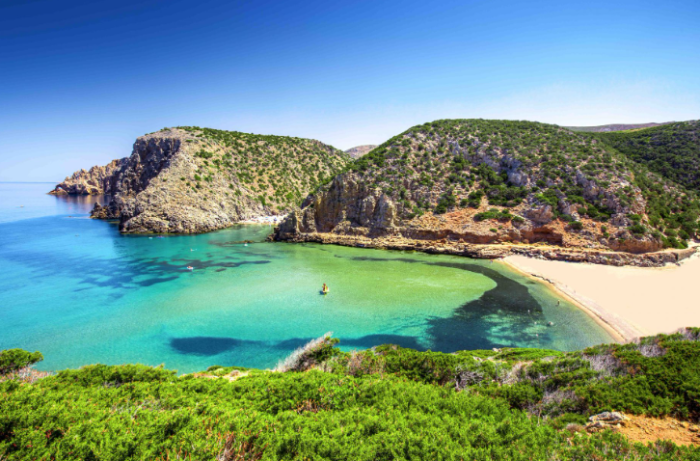
Sardinia, Italy’s second-largest island, is a paradise for beach enthusiasts. Known for its wild landscapes, ancient ruins, and vibrant culture, Sardinia’s coastline is dotted with some of the most beautiful beaches in the Mediterranean.
Best Beaches in Sardinia:
- Spiaggia Rosa, Budelli: Famous for its pink sand, Spiaggia Rosa is one of Sardinia’s most iconic beaches. Unfortunately, it’s now protected to preserve its delicate ecosystem, but you can admire it from a boat tour.
- Cala Goloritzé, Baunei: A UNESCO World Heritage Site, Cala Goloritzé is a secluded cove accessible only by boat or a challenging hike. Its towering limestone cliffs and turquoise waters make it a must-visit for adventurers.
- La Pelosa Beach, Stintino: With its shallow, emerald-green waters and fine white sand, La Pelosa feels like a Caribbean escape. The 16th-century Torre della Pelosa tower adds a historic touch.
- Cala Mariolu, Baunei: Another gem in the Gulf of Orosei, Cala Mariolu is known for its white pebbles and transparent waters. Snorkeling here reveals vibrant marine life and underwater caves.
- Spiaggia del Principe, Costa Smeralda: Part of the exclusive Costa Smeralda, this beach is frequented by the jet set. Its white sand and azure waters are framed by lush greenery, offering a touch of luxury.
Travel Tips:
- Sardinia’s best beaches are often remote. Consider renting a car or joining a guided tour to explore.
- The island’s interior is equally stunning, with mountains, forests, and ancient ruins worth visiting.
- Respect protected areas like Spiaggia Rosa to ensure their preservation for future generations.
3. Sicily: Where History Meets Coastal Beauty
Sicily, Italy’s largest island, is a melting pot of cultures, cuisines, and landscapes. From the active volcano of Mount Etna to the ancient Greek temples of Agrigento, Sicily offers a rich tapestry of experiences. Its beaches, however, are often overlooked but are equally captivating.
Best Beaches in Sicily:
- San Vito lo Capo, Trapani: This crescent-shaped beach is known for its fine white sand and crystal-clear waters. Surrounded by cliffs, it’s a popular spot for swimming, sunbathing, and water sports.
- Scala dei Turchi, Agrigento: A unique geological formation, Scala dei Turchi (the “Stair of the Turks”) is a white chalk cliff that resembles a staircase leading to the sea. The beach below is perfect for a relaxing day by the water.
- Isola Bella, Taormina: Just off the coast of Taormina, Isola Bella is a tiny island connected to the mainland by a narrow strip of sand. Its rocky shores and clear waters are ideal for snorkeling and exploring.
- Mondello Beach, Palermo: A favorite among locals, Mondello is a lively beach with a boardwalk, cafes, and a vibrant atmosphere. Its golden sand and shallow waters make it family-friendly.
- Rabbit Beach (Isola delle Conigli), Lampedusa: Often ranked among the world’s best beaches, Rabbit Beach is a secluded paradise with powdery white sand and turquoise waters. It’s a nesting site for loggerhead sea turtles, adding to its ecological significance.
Travel Tips:
- Sicily’s beaches are diverse, from lively resort towns to remote coves. Choose based on your preferred vibe.
- Visit the Aeolian Islands for volcanic landscapes and black-sand beaches.
- Try Sicilian specialties like arancini, cannoli, and fresh seafood while at the beach.
4. Puglia: The Heel of Italy’s Boot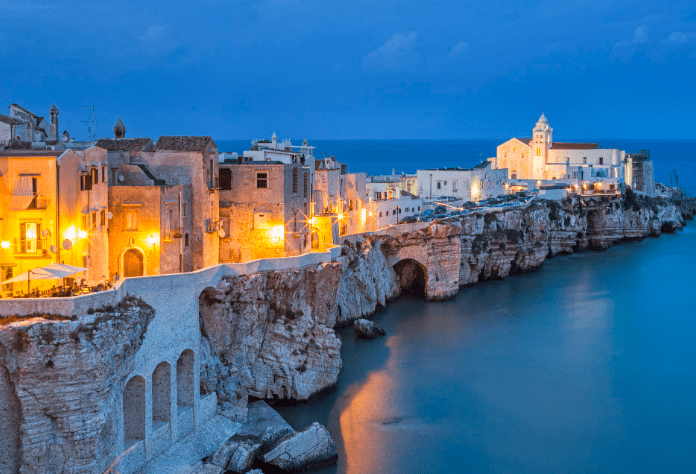
Puglia, the region forming the “heel” of Italy’s boot, is a hidden gem for beach lovers. Known for its whitewashed trulli houses, olive groves, and ancient towns, Puglia’s coastline is equally enchanting, with long stretches of sand and secluded coves.
Best Beaches in Puglia:
- Polignano a Mare: This cliff-top town is famous for its Grotta Palazzese, a restaurant carved a cave overlooking the sea. The nearby beaches, like Cala Porto, offer clear waters and dramatic rock formations.
- Baia dei Turchi, Otranto: A hidden gem near Otranto, Baia dei Turchi is a secluded beach with fine white sand and shallow waters. It’s perfect for a peaceful day by the sea.
- Pescoluse Beach (the “Maldives of Salento”): Known for its turquoise waters and powdery sand, Pescoluse feels like a tropical paradise. The beach is lined with beach clubs and cafes, offering a lively atmosphere.
- Porto Selvaggio, Nardò: A nature reserve, Porto Selvaggio is a rugged coastline with hidden coves, pine forests, and crystal-clear waters. It’s ideal for hiking, snorkeling, and nature lovers.
- Torre Guaceto, Brindisi: A protected marine area, Torre Guaceto offers long stretches of sandy beaches and clear waters. It’s a haven for birdwatching and exploring the Mediterranean ecosystem.
Travel Tips:
- Puglia’s beaches are often less crowded than those in more touristy regions, making them perfect for a relaxed getaway.
- Visit in the shoulder seasons (spring or fall) for mild weather and fewer crowds.
- Explore Puglia’s interior, with its historic towns, wineries, and olive oil tastings.
5. Liguria: The Italian Riviera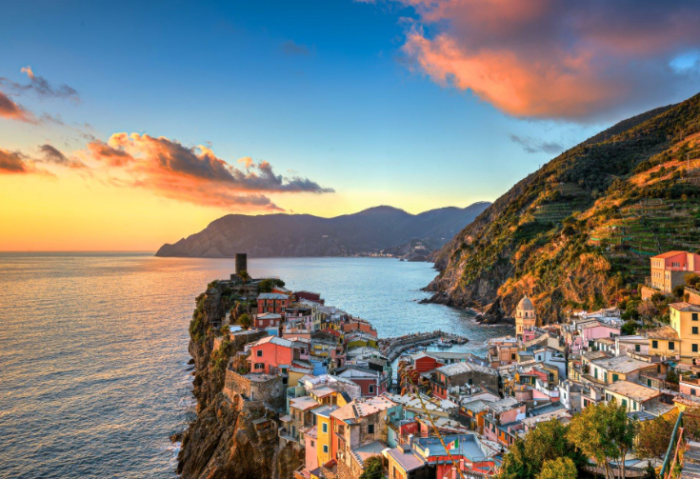
Liguria, home to the Italian Riviera, is a narrow strip of coastline known for its colorful villages, terraced vineyards, and rugged cliffs. While the region is famous for the Cinque Terre, its beaches are equally charming, offering a mix of pebble shores and hidden coves.
Best Beaches in Liguria:
- Monterosso al Mare, Cinque Terre: The only village in the Cinque Terre with a proper sandy beach, Monterosso is a popular spot for swimming and sunbathing. The beach is lined with cafes and restaurants, offering a lively atmosphere.
- Baia dei Saraceni, Varigotti: A secluded pebble beach near Finale Ligure, Baia dei Saraceni is known for its clear waters and dramatic rock formations. It’s perfect for snorkeling and exploring tide pools.
- Nervi Beaches, Genoa: Just outside Genoa, Nervi offers a series of pebble beaches and a scenic promenade. The Passeggiata Anita Garibaldi is a must-walk, offering stunning views of the sea.
- Camogli Beach: This charming fishing village near Genoa has a small, pebble beach with clear waters. The colorful houses and lively harbor add to its appeal.
- Sestri Levante, Bay of Silence: Famous for its two bays—the Bay of Silence and the Bay of Fables—Sestri Levante offers a peaceful retreat with rocky shores and calm waters.
Travel Tips:
- The Cinque Terre is best explored by train or hiking trails. Wear comfortable shoes and plan your itinerary in advance.
- Liguria’s beaches are often rocky, so bring water shoes for swimming.
- Try local specialties like pesto, focaccia, and seafood while in the region.
6. Tuscany: Beyond the Renaissance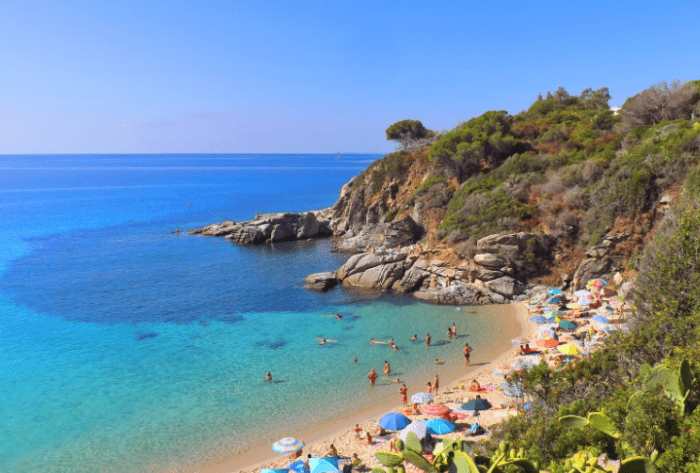
Tuscany, known for its rolling hills, vineyards, and Renaissance art, also has a stunning coastline that’s often overlooked. From the wild beaches of the Maremma to the elegant shores of Forte dei Marmi, Tuscany offers a diverse coastal experience.
Best Beaches in Tuscany:
- Marina di Bibbona: This long, sandy beach is perfect for families, with shallow waters and a lively boardwalk. The nearby pine forest offers shade and a break from the sun.
- Castiglione della Pescaia: A historic town with a medieval castle, Castiglione della Pescaia has a beautiful sandy beach and clear waters. It’s a popular spot for windsurfing and kitesurfing.
- Fetovaia Beach, Elba Island: Known as the “Caribbean of Tuscany,” Fetovaia is a secluded beach with white sand and turquoise waters. The island of Elba, where Napoleon was once exiled, offers a mix of history and natural beauty.
- Versilia Beaches (Forte dei Marmi, Viareggio): These elegant beaches are frequented by the wealthy and fashionable. With designer boutiques, beach clubs, and gourmet restaurants, they offer a touch of glamour.
- Cala Violina, Maremma: A hidden gem in the Maremma Natural Park, Cala Violina is known for its emerald waters and fine white sand. The beach is accessible only by foot or bike, adding to its seclusion.
Travel Tips:
- Tuscany’s beaches are often less crowded than those in other regions, especially in the off-season.
- Visit the nearby islands of Elba, Giglio, and Capraia for a unique coastal experience.
- Combine your beach trip with a visit to Tuscany’s historic towns like Florence, Siena, and Pisa.
7. Calabria: The Toe of Italy’s Boot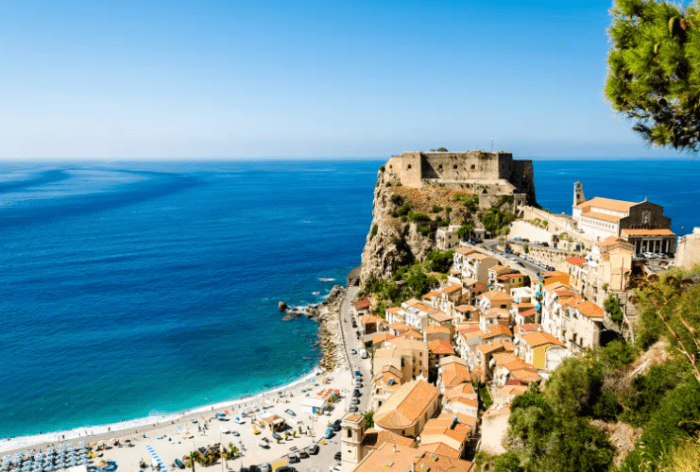
Calabria, the region forming the “toe” of Italy’s boot, is a rugged and wild part of the country. Known for its strong traditions, spicy cuisine, and ancient villages, Calabria’s coastline is equally captivating, with long stretches of sand and dramatic cliffs.
Best Beaches in Calabria:
- Tropea: This picturesque town is famous for its Santa Maria dell’Isola church perched on a rocky outcrop. The beach below, with its golden sand and clear waters, is a highlight of the region.
- Scalea: A family-friendly beach with a long sandy stretch and shallow waters, Scalea is perfect for a relaxed day by the sea. The nearby town offers shops, restaurants, and a lively atmosphere.
- Praia a Mare: Known for its Dino Island, a rocky islet with an ancient Roman villa, Praia a Mare offers a mix of sandy and pebble beaches. Snorkeling and diving are popular here.
- Capo Vaticano: A nature reserve, Capo Vaticano is famous for its white cliffs and crystal-clear waters. The beaches here, like Grotticelle, are secluded and perfect for a peaceful getaway.
- Soverato: This lively town on the Ionian Sea has a sandy beach and a vibrant nightlife. It’s a great spot for those who want to combine beach time with entertainment.
Travel Tips:
- Calabria’s beaches are often less developed than those in other regions, offering a more authentic experience.
- Try local specialties like ‘nduja (spicy spreadable sausage), caciocavallo cheese, and fresh seafood.
- Explore the nearby Sila National Park for hiking and nature adventures.
Practical Tips for Visiting Italy’s Best Beaches
- Timing is Everything: Italy’s beaches are busiest from June to August. Visit in May, September, or October for milder weather, fewer crowds, and lower prices.
- Transportation: Renting a car gives you the flexibility to explore remote beaches. Alternatively, use trains, buses, or boat tours to reach popular destinations.
- Accommodation: Book well in advance, especially in high season. Consider staying in nearby towns or villages if beachfront accommodations are too expensive.
- Packing Essentials: Bring sunscreen, a hat, sunglasses, water shoes (for rocky beaches), and a reusable water bottle. Many beaches charge for sun loungers and umbrellas, so bring a towel if you prefer to lie on the sand.
- Respect the Environment: Italy’s beaches are often protected areas. Dispose of trash properly, avoid disturbing wildlife, and follow local regulations.
From the glamorous shores of the Amalfi Coast to the secluded coves of Sardinia, Italy’s best beaches offer a diverse range of experiences for every traveler. Whether you’re seeking adventure, relaxation, or a mix of both, Italy’s coastline has something to offer. Plan your trip wisely, respect the environment, and soak up the sun, sea, and culture of this incredible country. Buon viaggio!
